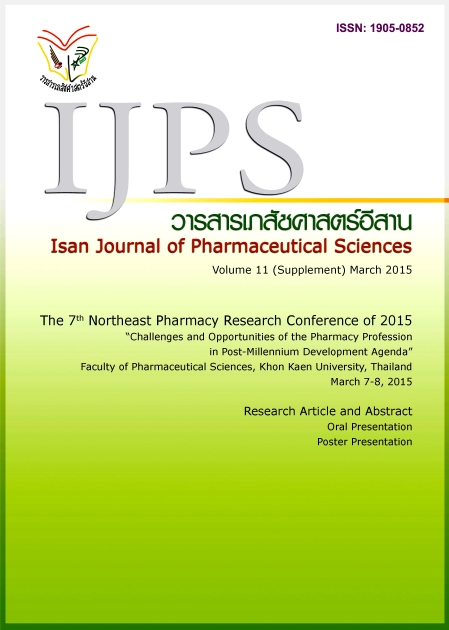Chemical Profiling and Antimicrobial Activities against Oral Pathogens of Ocimum spp. Essential Oils
Main Article Content
Abstract
Introduction: Recently, oral deceases are one of the most important problems in Thailand. These are generally treated by antibiotics which lead to antibiotics resistance. The uses of herbs to control oral pathogens are one of the alternative choices of treatment. The objectives of the research were to identify major chemical constituents of plants from Ocimum spp.; namely, white holy basil, purple holy basil and purple Thai basil. In addition, inhibitory and bactericidal activities against Streptococcus mutans, Streptococcus pyogenes, Staphylococcus aureus; and inhibitory and fungicidal activities against Candida albicans were also investigated. Method: Essential oils were extracted by means of water distillation. The resulting oils were then characterized by GC-MS. Antibacterial and antifungal activities were tested by agar disk diffusion method. Moreover, minimal inhibitory concentrations (MIC) and minimal bactericidal or fungicidal concentrations (MBC or MFC) were determined by broth dilution method. Results: Major chemical constituents of white holy basil and purple holy basil essential oils consisted of methyl eugenol at 54.29% and 51.21% by total area, respectively. While, major chemical constituent of purple Thai basil essential oils was methyl chavicol at 96.70% by total area. The MIC and MBC or MFC of essential oils were determined as followed. White holy basil and purple holy basil expressed the best MIC and MBC or MFC against C. albicans at 1.56 mg/mL and S. pyogenes at 0.78 mg/mL, respectively. In addition, purple Thai basil showed the best MIC and MFC against C. albicans at 6.25 mg/mL. Conclusion: White holy basil, purple holy basil and purple Thai basil essential oils exhibited high antimicrobial activities against S. pyogenes and C. albicans; moderate activity against S. mutans, and low activity against S. aureus.
Article Details
In the case that some parts are used by others The author must Confirm that obtaining permission to use some of the original authors. And must attach evidence That the permission has been included
References
Amber K., Aijaz., Immaculata X, et al. Anticandidal effect of Ocimum sanctum essential oil and its synergy with fluconazole and ketonazole. Phytomedicine; 17, 2010, 921-925.
Carovic SK, Orlic S, Politeo O, et al. Composition and antibacterial activities of essential oils of seven Ocimum taxa. Food Chemistry. 119, 2010, 196–201.
CLSI. Performance Standards for Antimicrobial Susceptibility Testing; Seventeenth Informational Supplement. M100-S17. Vol 27 No.1 Replaces M100-S16 Vol.26 No.3, 2007.
Harborne, J.B. Phytochemical Method. 3rd ed. London: Chapman & Hall, 1998.
Khan A., Ahmad A., Akhtar F, et al. Ocimum santumessential oil and its active principal exert their antifungal activity by disrupting ergosterol biosynthesis and membrane integrity. Res in Microbiol. 161, 2010. 815-823.
Kishore-Dubey N., Tiwari T., Mandin D., Andriamboavonjy H., Chaumont J., 2000. Antifungal properties of Ocimum gratissimumessential oil (ethyl cinnamate chemotype). Fitoterapia; 71, 567 – 569.
Lawrence, B.M., Hogg, J.W. and Terhune, S.J., The chemical composition of Ocimum basilicum and Ocimum sanctum. Perfume Essential Oil Record. Vol. 62.1971, 1-20.
Nakamura C., Ishida K., Faccin L., et al. 2004. In vitro activity of essential oil from Ocimum gratissimumL. against four Candida species. Res Microbiol; 155, 579 – 586.
Runyono D., Ngassapa O, Vagionas K, et al. Chemical composition and antimicrobial activity of the essential oils of four Ocimum species growing in Tanzania. Food Chemistry. 119. 2010, 311-316.
Steinberg S. A paradigm shift in the treatment of caries. Gen Dent. Jul-Aug; 50(4) 2002, 333-8.
Trombetta D., Castelli F, Sarpietro MG, Venuti V, Cristani M, Daniele C et al. Mechanisms of Antibacterial Action of Three Monoterpenes. Antimicrobial Agents and Chemotherapy, June 2005, 2474–2478.
Telci I., Bayram E, Yilmaz G, Avci B, Variability in essential oil composition of Turkish basils. Biochemical Systematics and Ecology 34. 2006, 489-497.
Zegra F, Kuckbay, Kuyumcu E, Selma, Celen, Ayse Dielek Azaz and Turan Arabaci. Chemical Composition of the Essential Oils Three Thymus Taxa from Turkey with Antimicrobial and Antioxidant Activities. Records of Natural Products., 2014, 110-120


